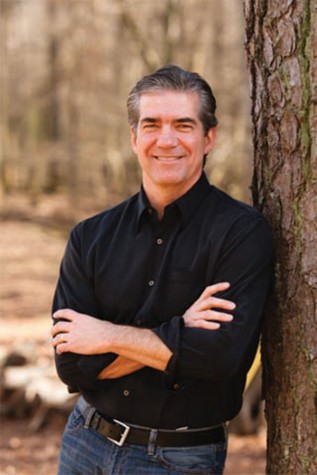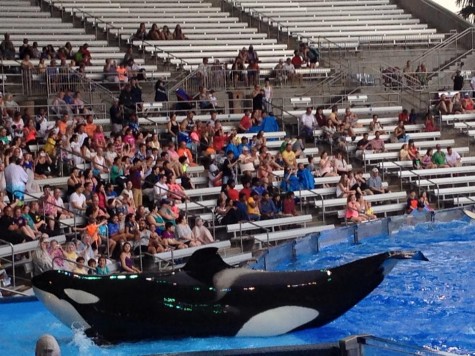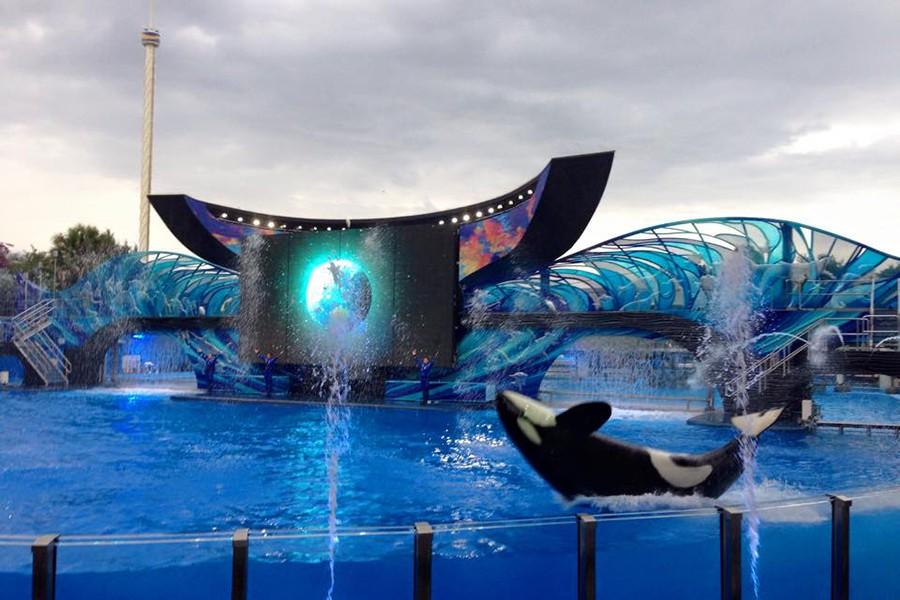Shamu goes out with the tide
SeaWorld Entertainment has announced the beginning of the end for captive orcas in their parks.
April 1, 2016
SeaWorld Entertainment, the source of much controversy in the past few years, has made a ground-breaking decision. Shamu is living his last years in the care of SeaWorld as they announce the end of an era.
On March 17th, 2016, Joel Manby, CEO of SeaWorld Entertainment, announced a historic decision to end all captive breeding of orcas (better known as killer whales) due to the outcry of the public after the CNN documentary “Blackfish” which was released in 2013.
We first announced that the orcas currently under our care will be the last generation in SeaWorld,” said Manby. “I have to stress that this was an incredibly difficult decision that cannot be underestimated. I have been in business for a long time. I’m 56 years old and I’ve never had to make a decision that was this difficult.
— Joel Manby
Manby believes that despite the challenges with the orcas, SeaWorld will be able to stay afloat only if they continue breeding other animals.
“Taking into account our other animals was a major part of the primary discussion with [The Humane Society of the United States],” said Manby. “I think that if [HSUS] had their way, they would love us to just be a rescue organization, but we cannot maintain the diversity of population with just rescue animals.
Orcas as Entertainment
Despite this decision, many students still do not stand by SeaWorld. Sophomore Kyra Wadley disagrees with SeaWorld and even disagrees with their decision to only end breeding, but believes that they should release all of the whales instead.
“Whales are not made for captivity, they’re made to live in the wild,” said Wadley. “They’re wild animals, not cats and dogs. No animal, no matter what size, should be taken out of the wild and forced to perform for people’s entertainment.”
Luckily for people like Wadley, Manby and the SeaWorld Entertainment Company has listened and has set plans for phasing out the theatrical performances.
“We will also be phasing out our orca shows and introducing an all-new orca encounter, that we are actually very excited about,” said Manby. “The basic intent here is that the environment will be more natural and their behavior will be much more like that you see of orcas in the wild.”
Manby believes that despite the draw of the theatrical shows, that the new encounters will benefit both the whales and the guests to SeaWorld parks.
“We will be shifting to [the new encounters] over a three year period,” said Manby. “First in San Diego, then in San Antonio, and finally in Orlando the year after that. We will still have timed experiences so that people can know when these encounters take place, but they will be organized around how they communicate, how they play, how they socialize, rather than being there for entertainment rather than education.”

However, sophomore Tyler Hall does not agree with SeaWorld’s plans, believing that no matter what they do, the orcas will always be used for entertainment.
“Keeping orcas in captivity is just wrong,” said Hall. “They were not created to provide our entertainment. They are wild animals! They should be treated as nothing less!”
Unlike Hall and Wadley, senior Vanessa LaRoche agrees with Manby and SeaWorld, agreeing that SeaWorld is an important educational facility.
SeaWorld and Education
“SeaWorld is an educational facility that helps to inform people about the wildlife of the sea and the reasons why we should protect it,” said LaRoche. “No animal is meant to be kept in captivity in all reality, but so many people only focus on the orcas, and that’s being a hypocrite. In reality, there are so many animals there that are in very similar situations, but the orcas are focused on because they’re the popular topic.”
However, LaRoche does agree with the idea of ending the breeding program at SeaWorld, believing that the purposeful breeding should not happen, but keeping orcas is okay in certain situations.
“I don’t agree with the breeding that SeaWorld is doing,” said LaRoche. “But if there happens to be a case where an orca needs to be rescued or is born in SeaWorld’s care without purposeful breeding, that is a situation I can agree with.”
Despite the fact that SeaWorld has announced the end of the breeding program, Manby does not agree that only bad things come out of it.
“In an ideal world, we believe that not preventing natural breeding would be the best for the animals,” said Manby. “However, all zoos control breeding to one extent or another, and we will be sure to do it, with experts, in the most humane way possible.”
Despite Manby’s announcement of the ending of theatrical shows, Wadley does not believe that SeaWorld will remain true to their word and will return to their entertainment background.
“I believe that [SeaWorld] is always going to be about entertainment [rather than education],” said Wadley. “They trained these animals for entertainment, they will never be able to just let them be.”
LaRoche agrees and disagrees with Wadley. Rather than believing that the whales will always be used as entertainment, LaRoche believes that SeaWorld has simply lost their focus.
“I feel like SeaWorld has become a very consumer-based corporation,” said LaRoche. “But most of these animals have been raised in captivity and the shows are what gets them exercise as well as draws in guests to SeaWorld.”
LaRoche believes that by reevaluating their position, SeaWorld would be able to become an educational establishment.
“SeaWorld needs to reevaluate itself to show that they are an educational facility and not a commercial corporation that many people see them as,” said LaRoche. “A lot of places, including Disney World and Universal Studios, have become so consumer-based that they are losing sight of the original plan for the facility.”
Manby states that this is a major mindset for many people that critique SeaWorld parks, whether supporters or otherwise.
“We decided that we needed to get ahead of this and move to a positive narrative about SeaWorld,” said Manby. “As you all know as our fans, SeaWorld has an incredible story to tell. A story about our rescue operations, how we help animals, how we educate about their plight in the wild. Sadly, the orca issue is becoming a barrier between our story and a growing audience.”
The New Partnership
Despite what many think, it wasn’t the outcry from the public that officially brought SeaWorld to the conclusion that they did. Instead, they partnered with a long time adversary, the Humane Society of the United States (HSUS.) Manby, however, was hesitant to work with the HSUS as they have a background of disliking SeaWorld very much.
“Our organizations [SeaWorld and HSUS] had not talked to each other in many years, but we had one thing in common: a mutual friend,” said Manby. “This friend was a congressman in California who trusted both of us and knew both of us, and since we both trusted him, we agreed to meet.”
Manby explains that the idea of SeaWorld working with the HSUS is not something that both parties will agree with each other at all times. However, he believes there is an importance to working with one’s adversaries.
“When Reagan and Gorbachev worked together, Russia and the United States didn’t agree on most things,” said Manby. “But they agreed on tearing down the Berlin Wall and promoting freedom in that city. I think that working with your adversaries to set aside your differences and push forward for the common good is the only way to get things done.”
Another major critique of SeaWorld is the belief that they caved under pressure. However, Manby insists that the decision was not caving in, but rather improving SeaWorld for all parties.
“I understand that the fans, and even some of our employees, feel betrayed based on our decision,” said Manby. “However, I truly believe that we didn’t cave to PETA or any other activist organization. We changed because society’s mindset was changing. Our data showed us that our customer base was shrinking, people didn’t like the idea of us having orcas in human care.”
Wadley also agrees that SeaWorld did not cave. However, Wadley wishes that they had, stating that this partnership can only do so much for the whales.
“I think that [HSUS’ involvement] is good for the animals,” said Wadley. “But it still isn’t great. These animals are still in tanks that are far too small for them and nothing will change until SeaWorld releases them or they all die.”
Don’t Free Willy
LaRoche disagrees with Wadley, believing that releasing all of the whales will do more harm than good.
“Releasing the whales is a big no-no,” said LaRoche. “They’ve been in SeaWorld’s care for so long, many since birth, that they wouldn’t understand how to live in the wild and would pose a threat to both people and to themselves. If people really want to see change, they’re going to have to simply let SeaWorld do what they’re doing and wait it out,”
Manby strengthened LaRoche’s position, stating how difficult it is to release animals into the wild after living their whole lives in captivity.
“There has never been a successful release of a whale or dolphin, born under human care, into the wild,” said Manby. “There are multiple examples of those failures, including Keiko, the whale from ‘Free Willy,’ who died only a few years after his release.”
Manby supported the keeping of orcas rather than releasing them by stating how well cared for each animal at SeaWorld is.
“Our whales have 24-hour veterinary service and a controlled water flow, we just don’t think it’s worth the risk to release them,” said Manby. “Almost all of our whales were born in SeaWorld and have known nothing else all of their lives. Along with this, I don’t think that it is worth the risk if they die, if there is a national disaster, oil spill, or anything like that. If any of that happens, who will be blamed? Not PETA or other activist organizations, but we here at SeaWorld.”
LaRoche also believes that having the orcas at SeaWorld really helps to encourage people to get involved.
“It is beneficial for people, especially children, to see these animals up close and in a controlled and safe environment,” said LaRoche. “Without this, they may never be inspired to help animals in the future.”
Manby believes that the change in the shows will be important for the whales, but believes that the trainers are still the most important part of the change.
“We are going to have our whales for a number of years, decades even, because of their length of life,” said Manby. “I have sat in a room with all of the trainers and answered their questions. They will still be here for a very long time, and their passion for the whales means that they want to stay. They know that they can take care of the whales better than anybody, and I know that is true.”
The “Blackfish” Controversy
Wadley spoke out attributing her distaste for SeaWorld to the 2013 CNN documentary “Blackfish,” the story of SeaWorld’s largest and most infamous orca, Tilikum. Tilikum has been the cause of three deaths since his capture back in 1981 by an Icelandic company and shipped to a Canadian ocean park. Tilikum was then transferred to SeaWorld in Orlando where he has lived since 1992. “Blackfish” showcased alleged poor living conditions and dangers of having such large animals in captivity. This presentation of uncomfortable and small tanks pushed Wadley over the edge.

“Seeing how sad those animals looked and hearing about the harm that they’ve caused to people, of course SeaWorld needs to change,” said Wadley. “All of the deaths could have been avoided if they just didn’t keep whales.
LaRoche, however, disagrees with Wadley, emphasizing the fact that “Blackfish” only made matters worse.
“Without it, [Blackfish], I don’t think that this whole crisis would be as big as it is now, if even getting attention from people other than PETA at all,” said LaRoche. “It’s the same thing as ‘Supersize Me’. Before that came out, nobody really cared about McDonald’s, but as soon as it did, everyone jumped on the ‘health craze’ bandwagon. The orca problem is nothing more than that: a bandwagon.”
Manby believes that despite SeaWorld’s criticism for being too “money-driven,” they still need to really think about what will make them the most money in order to keep SeaWorld afloat.
I would rather have a strong organization with supporters and cash flow so that we can pay our employees and care for our animals the right way than to have a park with controversy and dropping profit margins,” Manby said. “The way I see it is we could either have a SeaWorld without whales or a world without SeaWorld.
— Joel Manby
Stepping Forward
Despite all of the hard times that they have fallen on, Wadley believes that SeaWorld is taking the right steps towards the ultimate goal, but believes that they should keep pushing in order to eventually reach what she believes to be the right position.
“SeaWorld should continue to listen to [the public],” said Wadley. “Times have changed, and people don’t want to see animals in tiny little tanks anymore, they want to see them out in the wild. If SeaWorld keeps listening and simply releases the orcas, people will have fewer issues with them and may even visit.”
Hall also supports SeaWorld releasing all of the whales, believing that continuing to fight for the release of the whales will end up in their “freedom.”
“It’s a good idea for SeaWorld to listen to people,” said Hall. “They have loyal followers that stand by them, but there is a bigger majority crying out for the release of the whales. If they can hear some of our cries, we need to keep pushing forward to make them hear all of them.”
However, LaRoche doesn’t agree with Wadley or Hall. Instead, she believes that people just need to let the time go by and allow SeaWorld to take the necessary steps to bettering their establishment for themselves, their animals, and the general public.
“It’ll be a good 50-60 years anyway before there are no more whales at SeaWorld,” said LaRoche. “People just need to be patient and understand that SeaWorld is doing what is best for themselves as a business as well as for the animals in their care.”
Steps taken by both SeaWorld and the HSUS are improving the great war of animal ethics. While SeaWorld may be changing, they expect great things to come in the future with their partnership as they watch as the sun sets on Shamu’s days in the parks.
